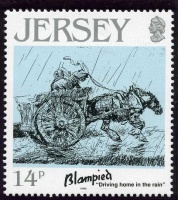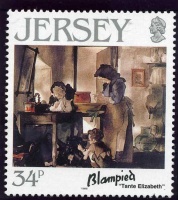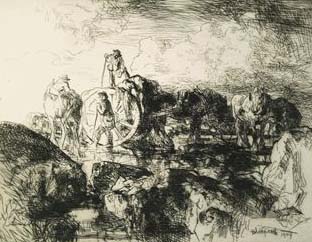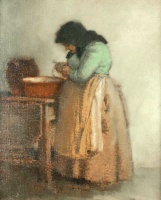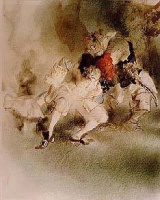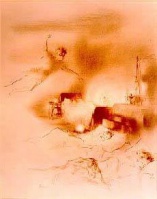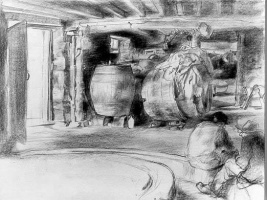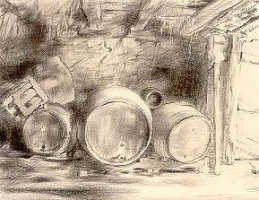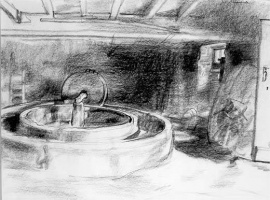Early years
Edmund Blampied was born on a farm in Saint Martin on 30 March 1886, five days after the death of his father, John Blampied. He was the last of four boys and was brought up by his mother, Elizabeth, a dressmaker and shopkeeper mostly at Augrès Trinity. He left the parish school at the age of 14 and went to work in the office of the town architect in Saint Helier.
It was a result of a visit in 1899 to the studio of John Helier Lander that Blampied decided that he wanted to make a career as an artist. Some of his pen and ink sketches of an agricultural show in May 1902 were noticed by Marie Josephine Klintz, who ran an art school. She gave the young Blampied his first formal lessons in art and introduced him to watercolours. His caricatures of politicians such as the Constable of St Helier, Philippe Baudains, during a local election brought him to the attention of businessman Saumerez Nicolle, who offered to sponsor him at art school in London, provided he tried to get a scholarship.
Art school
In January 1903, aged 16 and barely able to speak English, Blampied left Jersey to study at the Lambeth School of Art. After taking a test and submitting some drawings, in May 1904 he won a £20 London County Council Scholarship for two years to continue his studies. Later that year he was selected by the head of the art school to work part time on the staff of a national newspaper, The Daily Chronicle. His first published illustrations appeared on 13 January 1905.
Blampied’s earliest etchings are dated December 1909. His prints were first shown at an exhibition of students’ work in March 1914, in which his etching of an ox cart was noted by the correspondent of The Times.
Own studio
At the end of 1911, while he was developing his skills as an etcher, Blampied decided to try his luck as an independent artist with his own studio. The rapid developments in colour printing and advertising of the time were creating much work for commercial artists for book and magazine publishers in London. The first recorded illustration was for a piece of sheet music entitled Glamour Valse, published by Ascherberg, Hopwood and Crew. Blampied quickly gained commissions to provide drawings for Pearson’s Magazine, The Sketch, The Sphere, The Ladies Field, The Queen and The Graphic, many of which were signed "Blam", a diminutive first recorded in The Tatler in January 1916. He used this signature for much of his commercial work for books and magazines, including three children's books for the Edinburgh publisher Thomas Nelson and Sons.
On 5 August 1914 Blampied married Marianne van Abbé (1887-1986) who was the sister of Dutch-born artists Joseph and Salomon van Abbé. They had no children. Marianne had acted as his agent for several years before they married, and continued to do so until Edmund's brother John began working as an artist's agent in the 1920s. She was a great support to Blampied in his work and prompted him to travel and see the world.
Blampied’s early etchings were shown at the influential Modern Masters of Etching exhibition at the Leicester Galleries of Ernest Brown and Phillips in 1915. They later published his first prints.
Military service
When conscription was introduced in Britain in 1916, Blampied returned to Jersey in the autumn of that year to be prepared to be called up for military service. In June 1917 he was classified as not fully fit for active service and was put on guard duties in the Royal Jersey Militia. Although there was a gap in commissions for illustrations while he settled into military life, by early 1918 he had re-established his connections with book publishers Thomas Nelson and Sons of Edinburgh, for whom he illustrated many children’s books and annuals during and immediately after the war.
Exposition medal
The 1920s were his most successful decade during which he became a member of the Royal Society of Painter-Etchers and Engravers, exhibited in London to critical acclaim and was the subject of a monograph published by the Keeper of Prints and Drawings at the British Museum.
Blampied had started to experiment with lithography in 1920, as two lithographs were shown at his first solo exhibition, but they had been transferred to a lithographers' stone from paper, and he wanted to learn how to draw directly onto the stone. He turned to Archibald Hartrick, a founder member of the Senefelder Club of lithographers, who was teaching at the Central School of Arts and Crafts, and started evening classes there.
The School submitted two of Blampied’s lithographs with the work of other students to the Exposition Internationale des Arts Décoratifs et Industriels Modernes in Paris in 1925. The School won a Grand Prix for its works on paper and Blampied was one of 12 students who were awarded gold medals.
His early efforts caught the eye of the art critic Malcolm Salaman, who, in 1923, included Splash, splash in the first of a long-running series of annual volumes called Fine Prints of the Year, which included examples of Blampied’s work each year between 1923 and 1937.
Travel in Tunisia
At the end of 1926 Blampied gave up his work for books and magazines, sold his house and studio in south London, and travelled in southern France and north Africa for about five months. Some of his drawings from this period were bought by Martin Hardie for the Victoria and Albert Museum and for Eton College.
Blampied as humorist
When the market for etchings collapsed during the great depression in the early 1930s, Blampied reinvented himself as a cartoonist and caricaturist at an exhibition in 1931 called “Blampied’s Nonsense Show”. This brought out his love of the absurd and led to his only book, obscurely entitled Bottled Trout and Polo. In this period Blampied also published more than 30 humorous lithographs, many of dogs.
In 1931 he also returned to book illustration to design an edition of Travels with a Donkey in the Cevennes by Robert Louis Stevenson for The Bodley Head.
He returned to work for magazines in 1933 with a weekly series of illustrations in ink and sepia wash of British life for the Illustrated London News and continued with occasional cartoons for the Sketch between 1935 and 1938.
Peter and Wendy
In May 1938 Blampied was elected to the Royal Society of British Artists. Later that year he was asked to prepare some new illustrations for a lavish edition of Peter Pan, the rights to which had been bequeathed by J M Barrie to the Great Ormond Street Hospital for Sick Children. The Blampied Edition of Peter and Wendy was published in late 1939 or early 1940 and is one of the finest illustrated editions of this book. See pictures in gallery below.
German occupation
By the time Peter and Wendy was published Blampied had moved from London to Jersey with the intention of settling there. Even though by June 1940 it was clear that the Channel Islands would not be defended from the Germans, Blampied and his Jewish wife had decided to remain in the island.
During the Occupation they moved to Route Orange, St Brelade. When artist supplies became scarce he continued to work with a variety of makeshift materials including dry-points with a needle on a tobacco tin.
The lack of currency in Jersey led to a request to design bank notes which were issued in April 1942. A year later he was asked to design six new postage stamps for the island, and as a sign of resistance he cleverly incorporated the initials GR in the 3d stamp to display loyalty to King George.
Blampied remained in Jersey after the war, mostly working in oils and watercolours, except for a series of 12 silhouettes he published in 1950 and a few etchings in 1958, one of which he exhibited at the Royal Academy. He designed a postage stamp to celebrate the liberation of Jersey in 1947, and the first Jersey regional stamp issued in 1964.
Blampied’s early subjects – the farm workers, the vraic collectors, the townspeople of St Helier – were his lifelong inspiration. The island’s way of life held great interest for him. He wrote
- "the human quality in art has always appealed to me...I have always sympathised most strongly with the human’s effort for existence, his tragic mistakes, his humour."
Blampied died in Jersey on 26 August 1966, aged 80 years, leaving an unfinished painting on his easel. His ashes were scattered in St Aubin's Bay.


Other articles
Newspaper records
Bibliography
- Dodgson, Campbell (1926). A Complete Catalogue of the Etchings and Drypoints of Edmund Blampied.
- Salaman, Malcolm (1926). Modern Masters of Etching No. 10 Edmund Blampied.
- Salaman, Malcolm (1932). The lithographs of Edmund Blampied.
- Syvret, Marguerite (1986). Edmund Blampied.
- Arnold, A and Appleby, J (1996). A Catalogue Raisonné of Etchings, Drypoints and Lithographs of Edmund Blampied.
Stamps
During the Occupation stamps were produced in Jersey from designs by Edmund Blampied. In 1948, to celebrate the third anniversary of the Liberation, the British Post Office released new stamps incorporating Blampied drawings. When Jersey started issuing its own stamps, the first series featuring local artists in 1971 included one for Blampied
Gallery









